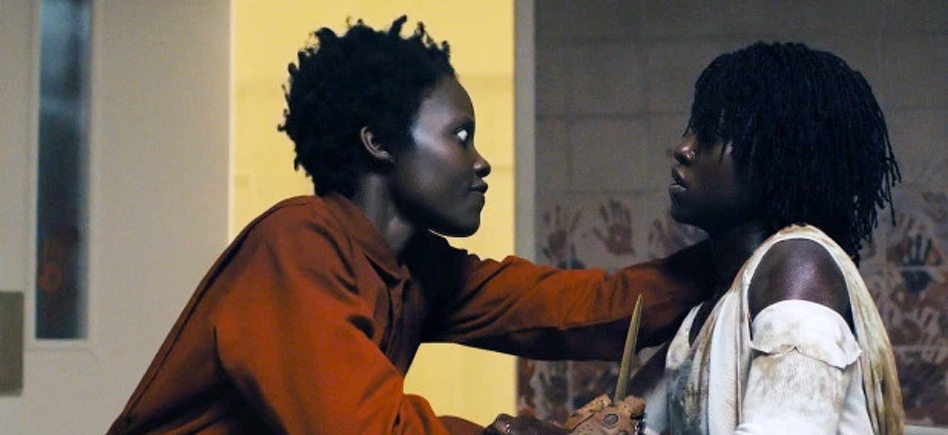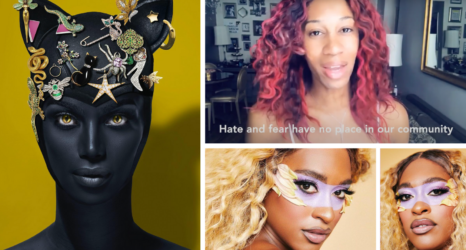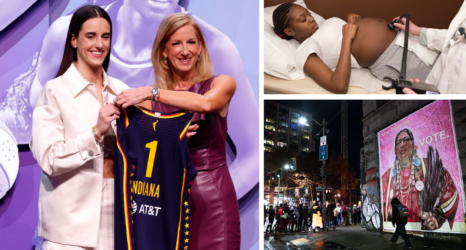WARNING: This review contains spoilers.

Jordan Peele’s sophomore horror film does not disappoint. Us, which follows Peele’s acclaimed 2017 debut Get Out, has even garnered a few firsts: It had the largest box office opening of any original horror movie and any movie starring a Black woman. The film is also filled with strong women leaders—and numerous symbols.
Peele’s sophomore film concerns the Wilsons: mother Adelaide (Lupita Nyong’o), father Gabe (Winston Duke), daughter Zora (Shahadi Wright Joseph) and son Jason (Evan Alex). The family comes under attack while on vacation by their doppelgangers, who call themselves the “Tethered,” since they share a soul with their counterparts, and who emerge from underground tunnels built conspiratorially by a nefarious U.S. government.
Despite the film’s historic milestones, it did not escape criticism—most notably in its depictions of disability. Nyong’o admitted in interviews that she derived inspiration from the vocal condition known as spasmodic dysphonia for her portrayal of Adelaide’s doppelganger Red, who speaks in a raspy and halting voice. She has since apologized, but some African American viewers have also wondered on social media why this particular horror film was bearing the burden of an ableist accusation, especially when far more blatantly ableist representations reverberate throughout horror films with white and/or male leads—most recently Split, Glass, Bird Box, A Quiet Place, and Halloween.
This observation of racial disparity in criticisms is important. It’s problematic to single out the one Black film in the genre for such a widespread problem, and such discourse also points to a lingering anxiety among Black audiences that our various performances of “Black excellence” will somehow be undercut as fraudulent.
I see these themes recurring throughout the film.
While Peele has said that Us, unlike Get Out, is “not about race,” it would be disingenuous to not discuss how race undergirds the social meanings throughout. The Wilsons operate as a “token” assimilable Black family in a predominately white community in Santa Cruz, California. The patriarch, Gabe, spends much of his time measuring himself against their white neighbors, the Tylers—played by Elizabeth Moss, Tim Heidecker, and twins Cali and Noelle Sheldon—who have a larger vacation home, a nicer boat and more expensive car.
This measurement against whiteness, even those whites who, for all intents and purposes, they don’t seem to really like, is part of the Black assimilation project in which they are constantly subject to a white gaze.
Even in childhood, young Adelaide is brought to Santa Cruz’s beach as a birthday gift from her parents—presumably after watching a commercial about it on the television screen on which the film opens. Neither Adelaide nor her parents seem to be enjoying themselves as the only African Americans at the theme park; instead, they go through the motions of “enjoyment,” as the TV commercial promised. Adelaide, wearing a Michael Jackson Thriller t-shirt that her father won for her in a carnival game, later callously drops a candied apple in the sand at the beach, but the conspicuous consumption of the carnival does not mask her parents’ constant bickering—which propels her to wander off and enter a funhouse called “Shaman’s Vision Quest – Find Yourself,” later called “Merlin’s Forest” when Adelaide returns as an adult. This detail is a stark reminder of the historic erasures of Native America—and it is in this funhouse of mirrors that young Adelaide first encounters her doppelganger.
In the film’s surprise ending, we learn that the young Adelaide—whom audiences have followed, believing her to be the film’s hero fighting a darker version of herself when she becomes a grown woman—was actually switched by her doppelganger, who assumes her identity above ground while leaving the real Adelaide underground to become the eventual revolutionary leader of the Tethered. This childhood switch sets the stage for the deep anxiety marginalized people have of being “imposters,” or “imposter syndrome,” as coined by psychologists Pauline R. Clance and Suzanne A. Imes.
Often times, high-achieving people of color and women, especially African American women, experience or are made to feel as if they are “imposters,” either in institutions of higher learning or in other professional spaces. When we first meet grown-woman Adelaide, she is introduced via Janelle Monae’s “I Like That”—signaling her existence as both “a mystery” and as someone who is “free.”
The song, in which Monae not only explores the duality of her identity but also signifies the words of great songstress Billie Holiday, frames Adelaide in a discourse of multiple identities and Black excellence. Her family home is filled with the markings of Black bougie culture like Afrocentric paintings and a poster of the Alvin Ailey Dance Company, which foreshadows her own experience of Black Girl Magic through ballet, the ultimate assimilationist art for the Black dancer.
These dance references signal the history of Black artists, including Jackson, who used dance and other art to elevate their humanity in the eyes of the larger culture, thus making them “acceptable” as well as upwardly mobile. (Jackson, of course, is the ultimate model of excellence and assimilation at the time of the movie’s opening, in 1986.)
In the climactic showdown between Adelaide and Red, the latter declares, “If it wasn’t for you, I would never have danced.” We are confronted in that moment with the transformative possibilities of Black art: Above-ground Adelaide was helped by her dancing to assimilate to white middle-class normalcy, but for below-ground Red, seemingly forced to mirror her double, it helped her start a revolution. Through this performance of excellence, we are left with more questions about who owns and is more in control of the “soul.” We are also left to ask if above-ground Adelaide, who appears less graceful in her movements in comparison to Red, is simply an imposter.
There is also another way to read the imposter: through the trickster figure.
In recent conversations, we have encountered celebrities who have been castigated as “tricksters”—the Black gay actor and singer Jussie Smollett, who was accused by the Chicago police of faking a hate crime; and Afro-Latina rapper Cardi B, who was accused of having “drugged and stole” from customers when she worked as a stripper, and then, in a misguided parallel, was likened to alleged serial abusers R. Kelly and Bill Cosby.
The undergirding theme of these stories about Smollett and Cardi B, or even R. Kelly and Cosby—that of the Black trickster who has accessed and/or exploited their wealth and fame through nefarious means—fosters a white supremacist view of the Black successful figure as untrustworthy, crafty and ultimately dangerous. This even ties in with the Michael Jackson reference in the film—the “patron saint of duality,” as Peele describes him—whose “Thriller” music video constantly undermines his nice-guy image through his sudden transformations into a werewolf, zombie and monster lurking underneath a façade. Jackson’s persona crafts both an above-surface image of childlike innocence and the below-surface trickster—both predatory, in regard to accusations of child sexual abuse; and financially, as manifested when Jackson allegedly outwitted both SONY and the Beatles for the band’s catalog.
Despite the demonization in the larger culture of the trickster figure, there is an alternative view that celebrates the trickster through the lens of African American and West African folklore—a tale of the marginalized turning the tables on the powerful.
“I had known about the capers Brer Rabbit is apt to cut,” Black proto-feminist anthropologist Zora Neale Hurston, for whom the daughter in the Wilson family is presumably named, sometimes viewed as a trickster figure herself, states in her introduction to Mules and Men. “But it was fitting me like a tight chemise. I couldn’t see it for wearing it. It was only when I was off in college, away from my native surroundings, that I could see myself like somebody else and stand off and look at my garment.”
Arguing for both a reflexive and distancing approach to Black culture, Hurston’s reflexivity also resonates with the themes in Us, in which our characters are continually shown gazing into mirrors and reflections. As Kinitra D. Brooks asks: “What if we don’t like what we see?” Do we work to “untether” ourselves from our mirrors, to create distance and a sharper view for introspection, as Hurston suggests?
This doppelganger confrontation is fraught with the flipping of scripts, and such reflexivity invites the projection of Black culture onto the narrative to literally flip the script of dominant culture, especially in celebration of the trickster.
Hurtston brought a reflexive academic lens on African American folklore trickster figures in Mules and Men; interestingly, they’re also teeming throughout the script of Us. The multiple rabbits appearing during the opening credits, as well as throughout the underground tunnels, could allude to Alice in Wonderland (and journeying “down the rabbit hole”) or just as easily to African American folklore figure Brer Rabbit—the trickster who is adept at escaping from traps. Very early in the story, above-ground Adelaide is associated with rabbits: In the basement of her home, she holds a toy rabbit from childhood while gazing at a mirror in the dance studio where she practiced ballet. She also eats “like a rabbit,” feasting on strawberries while her family eats fast food.
Another trickster figure is also invoked—Brer Anansi the spider. Young girl Adelaide whistles “Itsy Bitsy Spider” in the funhouse—which is then echoed by her double. Later, above-ground, grown-woman Adelaide observes a spider emerging from underneath a toy duplicate in her home. Given Red’s plans for an underground uprising, the lyrics to the childhood song, about the spider’s attempts to climb up the water spout, much like the below-ground pipes of the tunnels where the Tethered reside, offer yet another foreshadowing.
In the end, the surprise twist that above-ground Adelaide is not who we thought she was complicates her characterization as either “good” or “evil.” The deprivations below-ground make her hungry for a privileged life above, but she has also condemned Red to a life of hell by switching places with her double. Yet, as their powerful “pas de deux” dance battle reveals, Red appears to have more “soul,” even “seeing God” through her art, which above-ground Adelaide took for granted when she gave it up as an adolescent.
Red’s zealous outlook—reminiscent of revolutionary leaders like Harriet Tubman, “underground” railroad conductor who engaged in conversations with God; and Nat Turner, whose rebellion in Southampton was also God-inspired—maintains a certain innocence, violent uprising notwithstanding, while attempting gravitas through the more commercialized trappings of empty gestures like the 1986 “Hands Across America” campaign, which she first saw on television. (The campaign attempted to raise awareness of homelessness and poverty while failing in its mission during an era of “trickle down” economics.) Her lofty ambitions are eventually undercut by her craftier double when, like Brer Fox tricking Brer Rabbit with a tar baby, she attempts to entrap above-ground Adelaide by kidnapping her own “baby,” Jason.
Repeat viewings make it easier to see above-ground Adelaide as the trickster—someone who, in Brer Rabbit style, navigates the labyrinthine tunnels underground like someone “born and bred in the briar patch.”
When Red, who has shown both mercy and a deep need to tell her story, is mercilessly strangled by Adelaide, who ultimately resorts to her original tethered self, we witness the triumphant darker self—as reflected in the eerie “hands across America” demonstration across the national landscape, doppelgangers successfully replacing their above-ground doubles, much like the settlers who replaced Indigenous Americans. (Unless we wish to flip the script here with the promise of oppressed people rising up to reclaim the soul of a nation.) Our (anti)hero has eschewed the guilt of imposter syndrome to embrace the cunning of the trickster, who engages her own version of Black excellence.
In a premise of script-flipping that resides in a Black girl and her double jumpstarting a revolution, Black excellence via Black Girl Magic can indeed change the world. But in inheriting the world, has she lost her soul?





